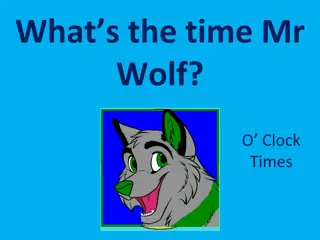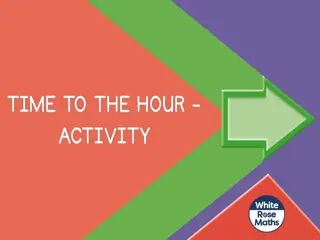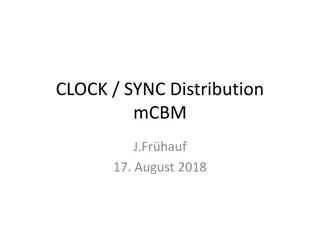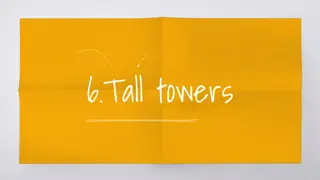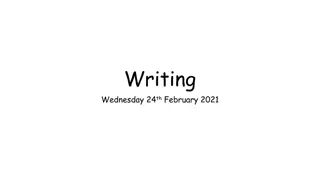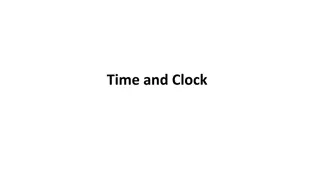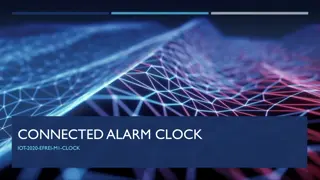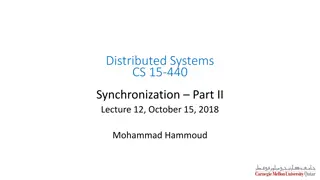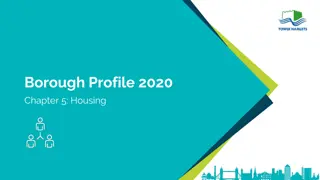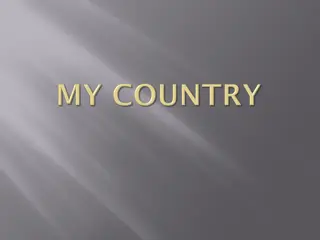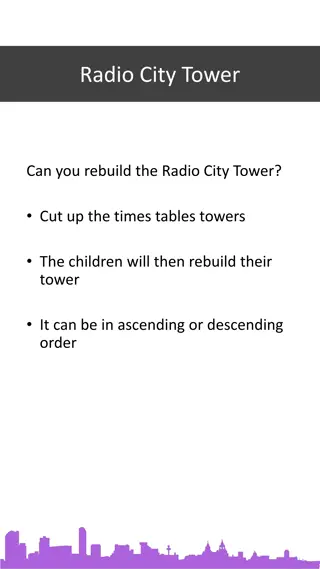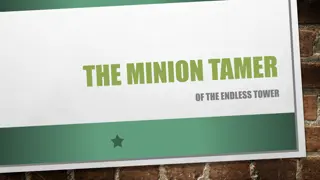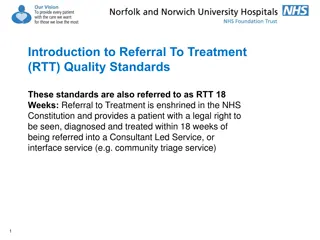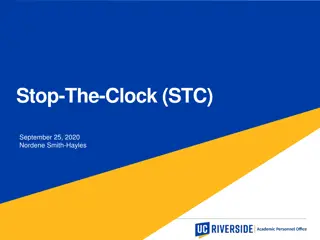The Enigmatic Clock Tower
In a captivating narrative inspired by The Clock Tower, a mysterious girl in a red dress alters reality by manipulating time through a magical clock tower window. As she embarks on a journey to restore the grey world outside, unexpected twists and deep realizations unfold, leaving readers spellbound with wonder and curiosity.
Download Presentation

Please find below an Image/Link to download the presentation.
The content on the website is provided AS IS for your information and personal use only. It may not be sold, licensed, or shared on other websites without obtaining consent from the author. Download presentation by click this link. If you encounter any issues during the download, it is possible that the publisher has removed the file from their server.
E N D
Presentation Transcript
Week 3 Writing. Unit A - The Clock Tower Outcome for the week. To plan and draft a short narrative, which will entertain the reader.
Word classes Every sentence you read is made up of different word classes. Which of these groups can your remember from last week, and what do you know now about them? Click return to be reminded of the word classes we looked at last week. The function of a noun is to name something. We looked at the difference between a common (concrete) and proper noun. We started to find out about noun phrases. nouns We looked at co-ordinating conjunctions, which we learnt as FANBOYS. We found out, their purpose is to join two simple sentences together. conjunctions This week, we will be looking at another type of noun, and determiners prepositions adjectives verbsadverbs pronouns
Lesson one- part One Word class: nouns Tell someone the difference between common (concrete) and proper nouns? Click return for Answers A common noun refers to general things, such as table, cat, chair, girl. A proper noun refers to a specific place or name, such as London, Upminster, Thomas, Charlie and the Chocolate Factory. A proper noun must have a capital letter. This week, we are looking at another type of noun, which we call abstract nouns What are abstract nouns? How could you find out? Click return for Answers Abstract nouns are a type of common noun, which means they don t have capital letters unless they start a sentence. They are difficult to define because they do not name physical things that can be touched or seen. They name feelings, ideas, occasions or time. Some examples are: love, happiness, bravery, trust, afternoon, health, beauty, hope
lesson one -part one. Word Classes:Nouns Look at The Bathers at Asnieres by George Seurat. Write five abstract nouns that could be linked to the painting
lesson one -part two. The Clock Tower How observant were you? 1. What is unusual about the numbers on the clock tower? 2. What colour dress is she wearing? 3. Why does she open the clock tower window? 4. What happens to the ground and buildings when she leaves the clock tower? 5. What do you think she realises after the green balloon she touches turns grey again. 6. What do you feel when you see how this ends? Watch the short video called, The Clock Tower. You might want to watch it a couple of times to notice everything that happens. Click on this link, which will take you to a Literacy website called Literacy Shed. The Clock Tower - THE LITERACY SHED Answers 1. 2. 3. 4. 5. They were Roman Numerals The dress was red. She sees balloons floating outside. Everything stops moving and the colour fades. She needs to go back to the wheel to make everything start up again.
lesson one -part three. The Clock Tower This week s task is to use, The Clock Tower, to write a short narrative. Task: to write a narrative (story). Audience: You are writing for other children your age and your teacher. Purpose: A narrative should be to entertain and engage the audience. When you read stories, how are they usually structured? Write the names of the different sections, you think a story needs. How many of these sections could you apply to the video you watched? Before you write a story, you need to develop a plan. To do this, you can either use the story mountain structure, or draw a straight timeline and add details in the order they should happen. In your plan, jot down key events that happened and split them into sections, so you can write three paragraphs. Draft your first paragraph.
Lesson 2 part 1 word class: noun What can you remember about abstract nouns? Tell someone what they do and how they are different from common and proper nouns? Click return for the answer. They are a special type of common noun, because they name things that can not be seen or touched. Abstract nouns can be made from nouns, verbs and adjectives. Abstract nouns made from verbs: Obedience from obey Growthfrom grow Pleasurefrom please Appearance from appear. Here are some abstract nouns that can be linked to adjectives to describe how people feel or behave. Look at them and work out what the adjective would be. anger, bravery, envy, happiness, sadness, wisdom and beauty Click return for answers The adjectives are: angry, brave, envious, happy, sad, wise, beautiful
lesson two -part two and three The Clock Tower Watch The Clock Tower again. The Clock Tower - THE LITERACY SHED Whilst you watch, look for what feelings the character might have. Add these abstract nouns and adjectives to your story plan. Explain to someone how to make a simple sentence. What must it have? What words can you use to join two simple sentences to make a compound sentence? Are these compound sentences or simple sentences that have be added to? The hands on the clock rotated, for the young girl continuously spun around. A small green balloon floated across the window. She did not want to be trapped in the tower, nor did she want the world to freeze around her.
lesson two -part three and four The Clock Tower Now, read through the draft of paragraph one. Proofread it for: Missing words Missing punction Words that are spelt incorrectly. Next, edit your paragraph to make improvements to the sentence structure and quality of language used. Check that any simple sentence used has a subject and a verb and makes sense on its own. Look for any compound sentences and check they have been structured correctly. Then look to see if there is anywhere else where a compound sentence can be developed. Finally, draft the second paragraph.
Lesson three- part one word class: nouns How can you make a piece of writing more interesting? Tell someone what is the purpose of a noun phrase What is the main difference between a noun phrase and a main clause (simple) sentence. What types of extra information could be added to a noun? Noun phrases provide extra information about a noun in the sentence. A phrase will not make sense on its own. A clause (simple sentence) must make sense. Look at the image from the video. How to make an expanded noun phrase Start with a determiner - an, a, the. 1. Write five examples of a noun phrase. 2. Add two adjectives before the noun to describe it. 3. Extend the rest of the sentence so it makes sense later.
lesson three part four The Clock Tower Now, read through the draft of paragraph two. Proofread it for: Missing words Missing punction Words that are spelt incorrectly. Next, edit your paragraph to make improvements to the sentence structure and quality of language used. Look for any compound sentences and check they have been structured correctly. Look for example of noun phrases or expanded noun phrases in your work. Finally, draft the third paragraph.
Lesson four- part one word class: determiners Are these phrases or clauses? A purple hat Answers- Are these phrases or clauses? A purple hat - phrase as no verb. The pale, white moon bathed the village in light. A clause as there is a subject and verb. The angry fox pounced. A clause as there is a subject and verb. An old, wise owl. A phrase as there is no verb. The pale, white moon bathed the village in light. The angry fox pounced. An old, wise owl. Phrases add extra information. They will only have a subject. A phrase does not use a verb. A clause must have both a subject and a verb. The most common determiners when writing a noun phrase are - a, an , the Write these determiners in front of different nouns to make a noun phrase. What do you notice about the nouns that follow a or an?
lesson three part two Expanded noun phrases A noun phrase acts as the noun in a sentence To turn a noun into a noun phrase you can add things before them, such as determiners and adjectives and adverbs You could also add things after them such as adverbial and prepositional phrases and relative clauses. More about this on the next slide. To make a good quality expanded noun phrase, first identify the HEAD noun. This is the actual noun in the sentence you want to change. E.G. Jack led the old-brown cow away. Jack and cow are both nouns; however, cow is the head noun because this is the one that has been changed.
lesson three part two Expanded noun phrases How to expand a noun phrase method 1. Add words before the noun. Those beans will be planted. Use a determiner. Those colourful, magical beans will be planted. Use adjectives. Several of those colourful, magical beans will be planted. Use amounts. That terribly large beanstalk shocked everyone. Use adverbs and adjectives. How to expand a noun phrase method 2. Add words after the noun. Beans with brown spots will be planted. The castle at the top of the beanstalk was huge. Use a prepositional phrase. Jack, who was only 10, slowly climbed through the leaves. Use a relative clause. How to expand a noun phrase method 3. Add words before and after the noun. Those colourful, magical beans with brown spots will be planted.
lesson three part two Expanded noun phrases Putting it together. Step 1 identify the nouns you want to turn into expanded noun phrases. Step 2 try adding words before them. Step three try adding words after them. To check if the sentence works, you should remove the expanded noun phrases and replace them with pronouns (me, I, it, he, she, they). Let s try. Step 1 = The bears went for a walk. Step 2= Those hungry bears went for a long walk. Step 3 = Those hungry bears, who had just woken up, went for a long walk in the woods.
lesson three part two and three Expanded noun phrases Your turn. Think about creating good quality expanded noun phrases. 1. The teacher raised his eyes and looked at the chair. 2. The lake was silent 3. The door was open 4. Lyddie walked to the ladder whilst keeping watch on the bear. 5. Charlie looked through the door at the Chocolate Room. 6. Write an example of your own. Now proof read and edit your story. You will complete this next week.


